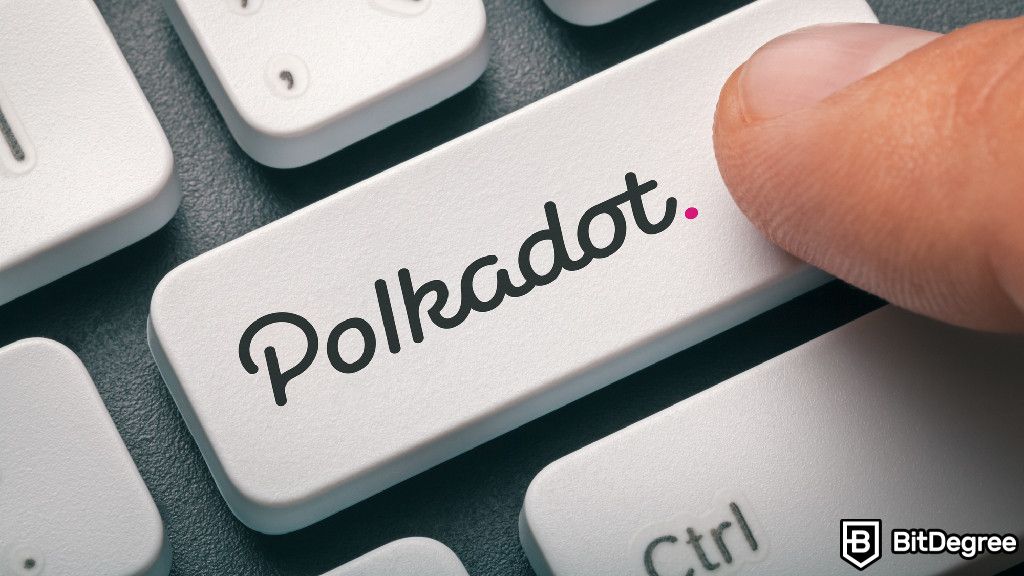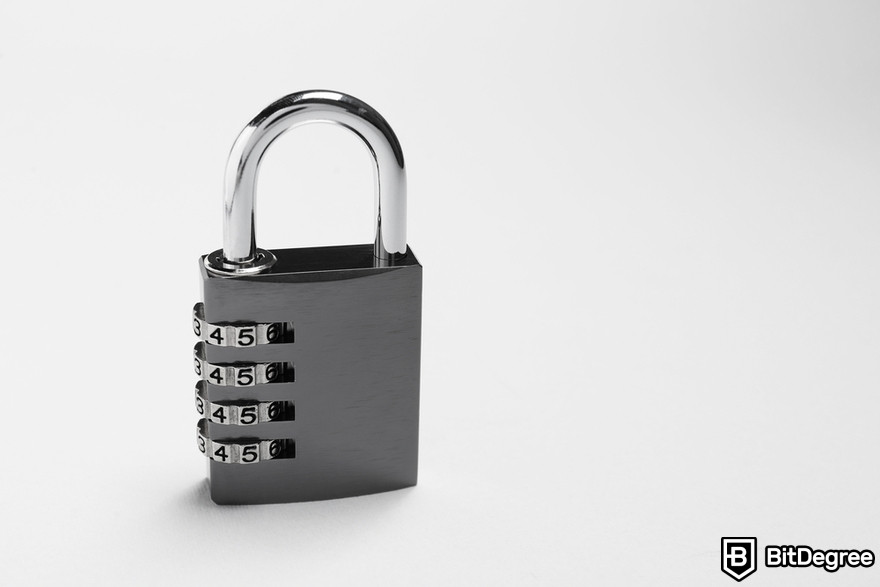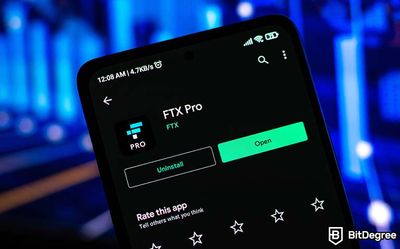Key Takeaways
- Polkadot staking allows you to earn rewards while contributing to the Polkadot network’s security and functionality;
- Staking Polkadot can be done through various methods, including native staking and centralized exchanges;
- Polkadot’s unique Nominated Proof-of-Stake (NPoS) model involves nominators and validators working together to secure the network.
Stop overpaying - start transferring money with Ogvio. Sign up, invite friends & grab Rewards now! 🎁
Polkadot staking is a great way to earn rewards while contributing to the security and functionality of the network. For those new to this coin, it's a blockchain designed to enable various blockchains to interoperate seamlessly.
Staking Polkadot (DOT) involves locking up your tokens to support network operations, such as validating transactions and securing the blockchain. Unlike other cryptocurrency staking methods, Polkadot relies on a unique system to secure its network. So, instead of directly validating transactions, you get to vote on who you trust to do the job.
That said, Polkadot staking can be a great option for you, whether you're a beginner or a seasoned crypto enthusiast looking to earn passive income. In addition, keep in mind that security is your top priority when holding crypto. It's important to securely store your DOT assets on a wallet, such as Ledger Nano X and Binance Wallet.

Did you know?
Subscribe - We publish new crypto explainer videos every week!
What is Polkadot in Crypto? (DOT Animated Explainer)


Table of Contents
- 1. Understanding Polkadot
- 1.1. What is Polkadot?
- 1.2. What is Polkadot Staking?
- 2. How to Stake Polkadot
- 2.1. Setting Up a Polkadot Account on Ledger
- 2.2. Connecting Ledger to the Polkadot Dashboard
- 2.3. Staking Your DOT Tokens
- 2.4. Staking Polkadot on a Centralized Exchange
- 3. Benefits of Polkadot Staking
- 3.1. Low Entry Barrier Through Nomination Pools
- 3.2. Transparent and Non-Custodial Nomination
- 3.3. Support the Network’s Decentralization
- 3.4. Participate in On-Chain Governance
- 4. Polkadot Staking Risks
- 4.1. Slashing Risks
- 4.2. Token Lock-Up Period
- 5. Conclusions
Understanding Polkadot
Before discussing the details of Polkadot staking, let’s first understand the basic aspects of the network. Understanding what Polkadot is and how it functions will provide a clear picture of why staking DOT tokens can be a beneficial option.
Latest Deal Active Right Now:What is Polkadot?
As I mentioned earlier, Polkadot is a multi-chain blockchain network designed to connect various blockchains and allow them to work together seamlessly. It ensures that different blockchains can interact without relying on trust. Polkadot also enables secure communication with external blockchains like Bitcoin and Ethereum[1], paving the way for a truly decentralized web.
One of Polkadot's key features is its interoperability. Unlike other blockchains that operate in isolation, Polkadot allows different blockchains to communicate and share information through its unique consensus mechanism. This is achieved using the Substrate framework, which simplifies the development of custom blockchains that can easily integrate with Polkadot.
Another key feature of Polkadot is its shared security model. All blockchains connected to the Relay Chain (the network's central hub) benefit from the network’s collective security, ensuring robust protection against cyber attacks.

By the way, blockchains connected to Polkadot’s central hub are called Parachains. They are project-specific blockchains integrated within the Polkadot and Kusama networks.
So, how does the shared security work? Imagine a building (Polkadot Relay Chain) with many rooms (Parachains). Instead of each room having its own guard, everyone inside is protected by a central team. As a result, everyone is protected with the same high level of security.
The Polkadot network is powered by its native token, DOT. It serves multiple purposes within the ecosystem, such as governance, staking, and bonding.
Governance allows DOT holders to participate in decision-making processes, influencing the network’s future. Staking lets holders delegate DOT to support network operations and earn rewards. Bonding DOT tokens is necessary to add new parachains to the ecosystems.
What is Polkadot Staking?
Now, let's discuss about Polkadot staking. In cryptocurrencies, it involves locking up a certain number of tokens to support network operations, such as transaction validation, security, and governance. In return, token holders earn rewards, typically through additional tokens. Polkadot staking follows this principle but incorporates unique mechanisms suited to its architecture.
Polkadot uses a unique model, Nominated Proof-of-Stake (NPoS). NPoS requires a set number of registered validators to confirm transactions, which will be determined by governance and grow with the number of parachains. Additionally, the Nominated Proof-of-Stake model allows any number of DOT holders to become nominators who enhance security by holding their tokens[2].

As explained above, this consensus mechanism relies on two main roles: nominators and validators. Here’s a detailed explanation of these two roles:
- Nominators: These participants select and back validators with their staked DOT tokens. Nominators play a crucial role in the network by choosing validators and ensuring that only performant validators are selected. While this role is less technically demanding than a validator's, they are still required to monitor validators' performance and reliability.
- Validators: They are responsible for producing new blocks and confirming transactions on the Polkadot network. They must also run nodes, maintain uptime, and ensure the blockchain’s security and accuracy. Validators are rewarded for their services but can also be penalized if they act maliciously or fail to meet performance standards.
Staking Polkadot is essential for the network's security and smooth operations. This way, both validators and nominators ensure safety against attacks and maintain a decentralized nature. The process incentivizes participants to act honestly and efficiently, as their assets are tied to their performance.
Additionally, staking not only supports network operations but also allows participants to earn rewards. Holders will receive their prizes based on the number of DOTs and the performance of the validators. Therefore, participating in Polkadot staking lets users contribute to the health and growth of the network, and also earn passive income through their tokens.
How to Stake Polkadot
Now, it’s time to explore the practical aspects of how to stake Polkadot. There are several ways of participating. Each approach offers different levels of involvement, risk, and reward potential.
Setting Up a Polkadot Account on Ledger
To get started, you’ll need a Polkadot-compatible wallet. Hardware wallets like Ledger Nano X can be a great choice, as they offer enhanced security for storing your private keys offline.
Here’s a step-by-step guide on how to set up a Polkadot account using Ledger Nano X:
Step 1: Open Ledger Live on your computer and navigate to the [Manager] tab.
Step 2: Search for [Polkadot app] in the application catalog.
Step 3: Click [Install] to download and install the app on your Ledger device. After a short moment, a confirmation message saying "Polkadot Installed" should appear in Ledger Live.
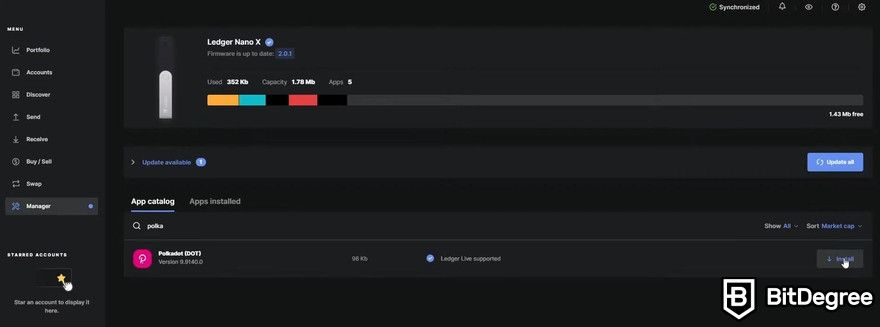
Step 5: Connect your Ledger Nano X device, name your account, and click the [Add account] button.
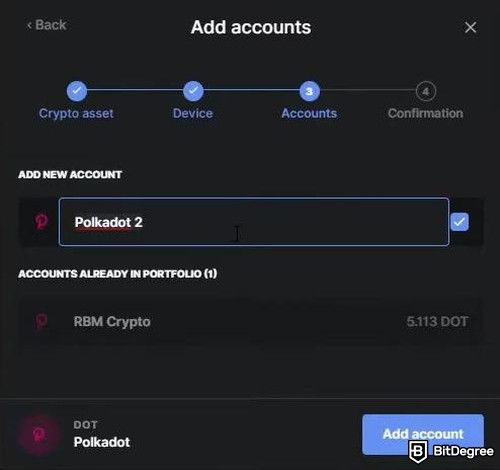
Congratulations! You've added a Polkadot account to your Ledger device.
Connecting Ledger to the Polkadot Dashboard
Now that you’ve set up your Ledger device and created a Polkadot account, you can connect your device to the Polkadot dashboard. Follow the steps below:
Step 1: Go to the Polkadot Staking Dashboard page.
Step 2: Click [Connect] at the top right corner of the screen. A window showing all available methods to connect to the Polkadot dashboard will appear.
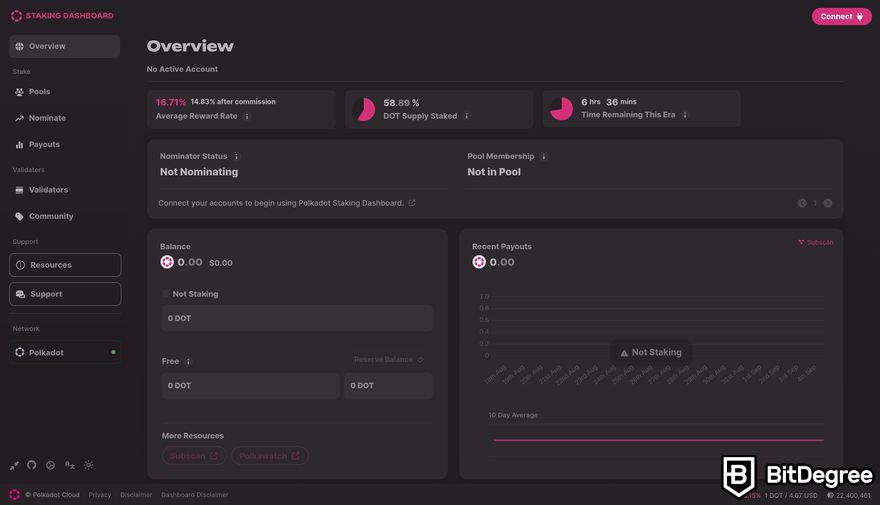
Step 3: Choose [Ledger] from the Hardware tab and click [USB]. Your web browser might ask you to connect with your Ledger Device. Confirm the connection attempt.
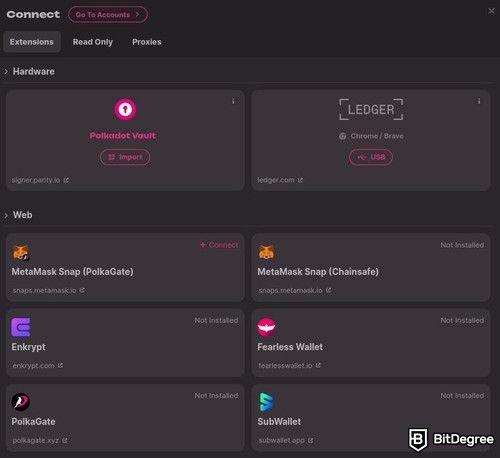
Step 4: Your default Polkadot Ledger account will appear. Create a name and click [Import]. Confirm the import and click [Done] to complete the process.
Step 5: You’ll be taken back to the connection option window. Click [Go To Accounts] and choose your Ledger account.
That’s it! You’ve connected your Ledger device to the Polkadot dashboard. From here, you can start holding your DOT tokens.

Did you know?
Subscribe - We publish new crypto explainer videos every week!
What Is Chia? | Crypto Finally Explained


Staking Your DOT Tokens
Polkadot offers a native staking method. This method allows you to use the DOT tokens within the network without using third-party platforms like crypto exchanges or wallets. This means the process starts and ends on the Polkadot network.
So, how to stake Polkadot using the native method? Here are the steps to hold your DOT using the Staking Dashboard:
Step 1: Go to the Polkadot Staking Dashboard and navigate to the [Nominate] tab on the left menu.
Step 2: Click the [Start Nominating] button. This will take you through several steps to complete holding DOT with your account.
Step 3: Select the reward destination – where your Polkadot staking rewards will be sent. There are three options: Compound, To Your Account, and To Another Account.
Step 4: Select the validators you want to nominate. There are up to 16 validators on Polkadot and 24 validators on Kusama. You can automatically generate your nominations using three available options, such as Optimal Selection, Active Low Commissions, and From Favorites, or manually insert them by selecting the Manual Selection option.
Step 5: Enter the amount of DOT you want to bond. I recommend you don’t delegate all the funds in your account. You’ll need a transferable balance to pay for future transaction fees. Additionally, you’ll need at least 100 DOT tokens to be able to nominate on Polkadot (minimum tokens might change).
Step 6: Click [Continue] to complete the step. You’ll see a summary of the preferences and amount of DOT tokens you wish to bond. Ensure that the information is correct.
Step 7: Hold your funds by clicking the [Start Nominating] button. Sign the extrinsic to complete the process. Once the extrinsic is broadcasted to the network, you’ll be taken back to the Nominate screen.
After completing the steps, you should have successfully staked your DOT tokens on Polkadot. Regularly visit to check the status of your nominated validators.
Staking Polkadot on a Centralized Exchange
For those looking for an alternative to the native Polkadot staking method, centralized exchanges offer a convenient and accessible option. Centralized exchanges are user-friendly and often have additional features like flexible staking terms and high liquidity.
Speaking of holding this token on a centralized exchange, where is the best place to stake Polkadot? Binance, Bybit, and Kraken are popular platforms for this purpose because they offer convenience and potentially great rewards.
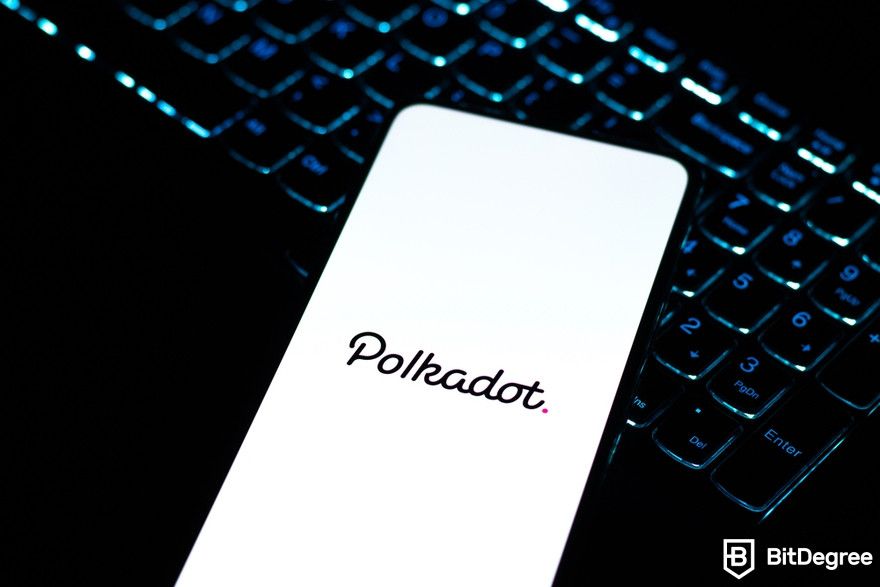
With these exchanges, you can make a profit without needing to manage your own validators or worry about the technical complexities involved in the native method. That said, let’s take a closer look at how Binance, Bybit, and Kraken offer their staking features.
Binance
Binance is widely regarded as the best place to stake Polkadot, offering some of the highest rewards in the market. It also has several options. These include flexible savings that allow users to withdraw their delegated DOT tokens at any time and fixed-term with a high annual percentage yield (APY).
Bybit
Bybit provides a competitive alternative for holding Polkadot, especially for those who prefer flexible staking options. With Bybit you can earn rewards without committing to long lock-up periods. This particularly benefits active traders who want to keep their funds accessible.
Kraken
Kraken is one of the best places to stake Polkadot, as it’s known for its simplicity and accessibility, making it a great choice for both new and experienced users. It offers up to 12% APY with flexible terms, allowing users to withdraw their DOT anytime.
When choosing the best place to stake Polkadot, especially on a centralized exchange, I recommend conducting in-depth research on how the process works and how the rewards are distributed.
Once you've chosen your preferred exchange, you can start holding your DOT tokens. That said, you might also wonder how to stake Polkadot on an exchange. For instance, here are the steps to do it on Binance:
Step 1: Go to Binance and log in to your account. If you don't have one, you'll need to create it. To do so, simply click the [Sign Up] button and follow the instructions. You must also complete the Know Your Customer (KYC) verification process to access all the features.

Step 2: Deposit DOT tokens by purchasing them with available payment methods, such as bank transfer and credit or debit cards. Alternatively, you can deposit them from a wallet or another exchange.
Step 3: Navigate to the [Earn] link at the top navigation menu.
Step 4: On the Binance Earn page, search for "Polkadot" or "DOT" in the search box and select it. Remember that Binance offers flexible and fixed-term staking options. Select the one that best suits your needs.
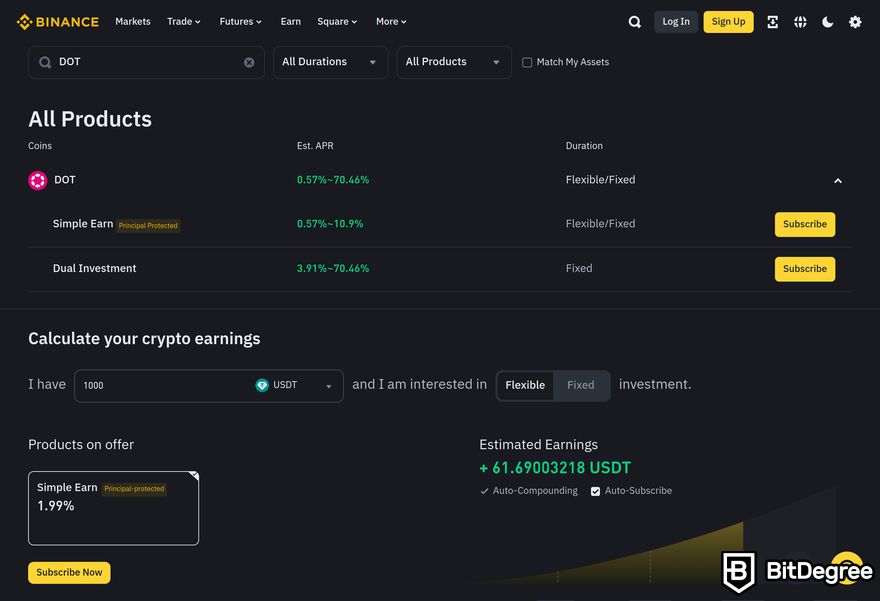
Step 5: Click [Subscribe] to your preferred staking plan. A window will appear showing the required fields for the next steps.
Step 6: Enter the amount of DOT tokens you want to stake. Then, agree to the Binance Simple Earn Service Terms & Conditions by marking the checkbox.
Step 7: Click [Confirm] to complete the transaction.
After completing the above steps, you can monitor the status, like the Polkadot staking reward in the dashboard.
Benefits of Polkadot Staking
Now that you know how to stake Polkadot, let's explore the advantages of holding DOT tokens.
Low Entry Barrier Through Nomination Pools
The first benefit of Polkadot staking is that the network has a low entry barrier through nomination pools.
That said, if you're not familiar with this term, let me quickly explain. Nomination pools allow users to combine their DOT tokens with those of other participants. This collective mechanism ensures that even small investors can partake in staking, enhancing inclusivity and broadening participation within the network. Additionally, the nomination pools operate by allowing multiple nominators to back a single validator collectively. This means that even if you have a small number of DOTs, you can still contribute to the network's security and earn rewards according to your contribution. 
Moreover, the advantages of lower entry barriers through Polkadot's nomination pools vary. For small investors, it means they can earn Polkadot staking rewards without accumulating a large number of DOT tokens. Additionally, the network benefits from increased security and decentralization, as a wider distribution of held tokens helps protect against potential attacks.
So, Polkadot staking through nomination pools not only supports personal financial growth but also strengthens the network. This makes it a win-win for both individual investors and the Polkadot community as a whole.
Transparent and Non-Custodial Nomination
Another benefit of Polkadot staking is that the nominators select validators they trust to secure the network and validate transactions. Meanwhile, validators work to maintain the blockchain's integrity. This process is not only transparent but also decentralized. Nominators can see which validators they are backing and their performance in real time.
Transparency in Polkadot staking operations offers several advantages. First, it allows nominators to make informed decisions about which validators to support based on performance metrics and historical data. Second, transparency fosters trust within the Polkadot community, as all actions and outcomes are visible on the network.

Additionally, the non-custodial nature of Polkadot’s nomination process provides significant security benefits, unlike custodial staking, where a third party holds tokens. Non-custodial nominations ensure that nominators always retain control over their DOT tokens.
Furthermore, by maintaining control of their own DOT tokens, nominators can quickly respond to changes, such as switching validators if a chosen one underperforms or behaves maliciously. This flexibility enhances the security and resilience of the staking process.
Support the Network’s Decentralization
Lastly, by staking DOT tokens to the Polkadot network, users can support the network's decentralization.
Decentralization is one of the core principles of blockchain technology, ensuring that no single entity controls the entire network. This is crucial for maintaining security, transparency, and trust within the ecosystem. Polkadot's unique staking mechanism achieves decentralization by distributing control and authority among validators and nominators.
So, staking Polkadot contributes to the network’s decentralization. This process spreads authority across many validators rather than concentrating it in the hands of a few. The NPoS consensus mechanism further enhances this decentralization by allowing nominators to select multiple validators, thus reducing the chances of any single validator gaining too much influence.

Moreover, individual nominators play a crucial role in maintaining Polkadot’s decentralized network. They help ensure that a diverse and trustworthy set of validators is chosen. This active participation not only supports the network’s operational integrity but also strengthens its decentralized nature.
Each nominator contributes to a dynamic and balanced network structure by choosing validators and potentially switching their nominations based on performance. This widespread participation is essential for preventing centralization and fostering a healthy, decentralized ecosystem.
Participate in On-Chain Governance
Polkadot’s unique on-chain governance model allows all stakeholders to participate in decision-making processes to shape the network’s future. This ensures that it evolves fairly and transparently, providing the pitfalls of centralized control.
Additionally, Polkadot’s governance model, known as OpenGov, replaces earlier centralized elements like Council and Technical Committee with a more flexible and decentralized approach. All DOT holders can participate in network changes, from protocol upgrades to treasury allocations.
For example, nominators can vote on proposals, delegate their voting power, and even submit new proposals. However, the nominator’s voting power is influenced by the amount of DOT tokens they have staked and the duration they’re willing to lock their tokens.

Moreover, delegating DOT not only secures the network but also empowers nominators to support the blockchain network's scalability. Nominators participate in governance by voting on key issues and proposals. This decentralized decision-making process ensures all stakeholders have a say in the network’s upgrades and changes.
For instance, significant decisions like protocol upgrades and treasury allocations are made through community referenda, where the nominators’ votes determine the outcomes. This democratic approach helps maintain the network’s security and continuous improvement.
Polkadot Staking Risks
While Polkadot staking offers numerous benefits, it also comes with certain risks that participants should be aware of. Understanding these risks is crucial for making informed decisions and safeguarding your investments while contributing to the Polkadot network. So, let’s explore the risks associated with Polkadot staking.
Slashing Risks
First, let's discuss about slashing risks. What are they? Slashing is a mechanism used in Polkadot staking to penalize validators and nominators for malicious behavior or operational failures. It enhances network security by discouraging and penalizing actions that could compromise the blockchain’s integrity.
Slashing can occur under several circumstances. One common scenario is double signing, where a validator signs two different blocks at the same height, indicating an attempt to fork the chain, which is a severe violation.
Another example is offline behavior, where validators are expected to be online and available to validate transactions continuously. So prolonged offline periods can lead to slashing as they fail to fulfill their role in maintaining the network.
When a validator is slashed, a portion of their DOT tokens is forfeited as a penalty. Unfortunately, the penalty extends to the nominators who have held their DOT tokens with that validator. This means nominators can also lose their tokens proportional to the validator’s stake. Therefore, it's important for nominators to monitor their chosen validators’ performance and behavior.

- Secure and reliable
- Accepts fiat currencies
- Lots of trading options
- Reputable exchange
- Accepts fiat currencies
- Offers various trading options

- Huge trading variety
- Regulation-compliant around the globe
- Fair trading fees
- Beginner-friendly
- A wide array of features
- Vast number of different crypto coins & tokens

- Beginner-friendly
- Secure
- Decent trading and withdrawal fees
- Crypto.com Visa Card
- Automated tools & bots
- Ecosystem synergy with CRO
Token Lock-Up Period
In Polkadot staking, the token lock-up period is an essential aspect that participants must consider. It refers to the time during which DOT tokens are locked and can’t be transferred or used.
When you stake your DOT tokens, the tokens are bonded to a validator. This bonding process includes a commitment to keep the tokens locked for a specified duration. This period ensures that validators and nominators remain dedicated to the network’s security and functionality.
The lock-up period in Polkadot staking is approximately 28 days. During this time, the tokens are inaccessible for transfers or other uses. The period begins if you decide to hold your tokens. When you initiate an unbound request, the tokens remain locked until the period ends.
Having funds locked up for a specific period can present several drawbacks. One of the main challenges is the lack of liquidity, where staked tokens can’t be used for other investments or transactions until the lock-up period concludes. This can be particularly disadvantageous during market fluctuations when participants want to liquidate their assets quickly.
So, if you want to hold your DOT tokens, you must plan your staking strategy carefully to avoid financial inconveniences.
Conclusions
Polkadot staking offers a compelling opportunity to earn rewards while bolstering the security and functionality of the network. Whether you’re a seasoned crypto enthusiast or a newcomer, understanding the intricacies of Polkadot staking can enhance your investment strategy.
You can hold your DOT tokens on Polkadot via its staking dashboard. This method requires you to set up a wallet and connect it to the dashboard. For beginners seeking the best place to stake Polkadot, centralized exchanges like Binance, Bybit, and Kraken provide user-friendly platforms with attractive rewards.
To wrap up, staking Polkadot not only offers financial rewards but also plays a crucial role in supporting the network’s health and growth. By carefully selecting reliable validators, you can maximize your experience and contribute to the Polkadot ecosystem. Whether you hold Polkadot natively or through an exchange, the potential for earning and supporting the network makes Polkadot staking a valuable addition to your crypto journey.
The content published on this website is not aimed to give any kind of financial, investment, trading, or any other form of advice. BitDegree.org does not endorse or suggest you to buy, sell or hold any kind of cryptocurrency. Before making financial investment decisions, do consult your financial advisor.
Scientific References
1. H. Abbas, M. Caprolu, et al: ‘Analysis of Polkadot: Architecture, Internals, and Contradictions’;
2. J. Burdges, A. Cevallos, P. Czaban, R. Habermeier, et al: ‘Overview of Polkadot and its Design Considerations’.
